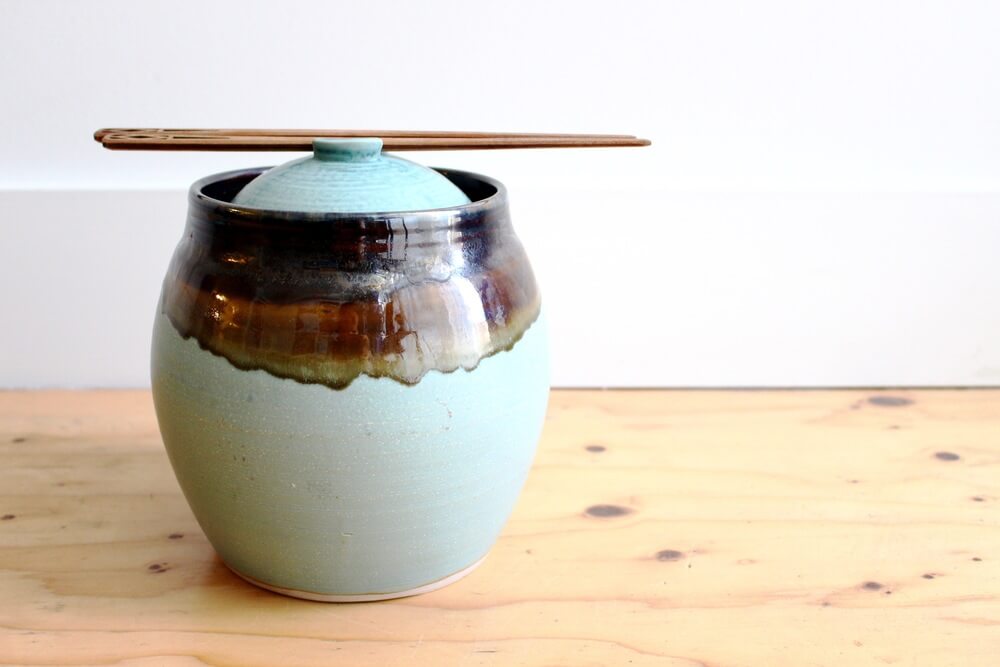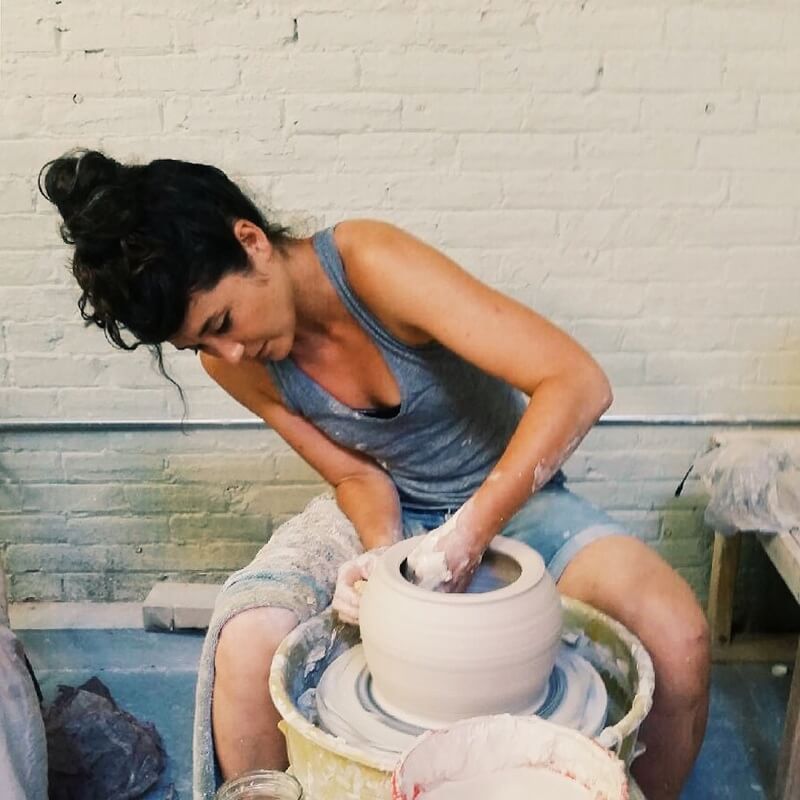15 Nov / Meet the Maker–Handcrafted Fermentation Crocks by Miki Palchick

While I love making kimchi, I can’t imagine making it in a traditional kimchi fermentation crock–called onggi—and then burying it in the ground. Although if you’d like to try it, you can buy one stateside from this guy.
Just so you know, fermenting in general doesn’t require a designated fermentation crock or other fancy equipment. This is all you need:
- A vessel– just about anything you have around the house–think buckets, mason jars, jelly jars, etc., etc.
- Weights—ceramic weights, a plate, veggie stems, a plastic bag filled with water.
- Gloves are important, especially when handling chili peppers!

This gorgeous fermentation crock handmade by Miki Palchick is glazed with the color of the sky (Photo credit: Sophie Sarkar)
However, if you’re looking for a gift for the home fermenter in your life or simply love beautiful things, Miki Palchick’s hand-thrown fermentation crocks would look just at home on your kitchen counter or in an art gallery.
Miki started making her signature fermentation crocks about five years ago. Admittedly, she started making them because she saw a business opportunity. “(I saw) that not a lot of crocks were available and wanted to offer an alternative that speaks to cultural food practices.”
Miki’s passion for this particular type of pottery stems from childhood, having grown up gardening and eating various pickles and fermented foods. “My mom’s side is Japanese and Dad is Jewish,” she says. “I’ve always liked pickles … that combo of sour and salty … especially dill pickles.”
Today, Miki is also a farmer and food educator and working with clay allows her to connect the dots across all her passions. “Fermentation lends itself well to people like me,” she explains and finds joy in creating vessels she can use to prepare and serve food for her loved ones.

This squat and round crock is one of three shapes that Miki creates. Every crock comes with matching weights. (Photo credit: Sophie Sarkar)
Drawing from both Eastern and Western traditions, Miki’s design encompasses the best of two worlds.
Like a lot of Japanese pottery (a prime example is the donabe which she also produces), the fermentation crock’s lid comes with a handy (haha …) handle for many uses: nestle a pair of chopsticks in the groove for checking your pickles; and flip the lid over to act as a dish for pickle-tasting.
Traditional Korean onggi usually have an oversized lid that that covers the top of the vessel instead of sitting inside the mouth. Here, Miki chooses to fashion her crock in the style of a German sauerkraut crock with an inset lid and an inner lip. The lid rests in the lip thus forming an airtight water-seal.

This cool diagram from Miki’s web site highlights the clever details of her vessel’s design. (Illustrator: Justin Turkus)
Not surprisingly, Miki looks to the natural world for ideas and inspiration. She sculpts with brown clay and is attracted to hues found in nature–blues, browns, greens. Like all organic matter, her ceramics are not perfectly symmetrical or smooth.
Ask her how big her crocks are, and Miki isn’t quite sure. They come in three different shapes and are about 1-gallon in size, she says. Even though she always starts with eight pounds of clay, the final product is unpredictable. “It depends on air bubbles, how wet the clay is …” She can only guarantee that each vessel is one-of-a-kind.

This photo of Miki was taken at The Cedar Works, a 15,000 square foot reclaimed warehouse, located in the Cedar Park neighborhood of West Philadelphia, that has been renovated into a community-oriented work and meeting space. (Photo credit: Stefani Threet)
Miki fires her pottery at 2,300 degrees F so it’s vitreous (not porous), and coats her pieces with a lead-free, food-grade glaze. And yes, they are microwaveable.
Find Miki’s works of art at craft fairs in the Philadelphia area, visit her studio, or order online at Clay Kitchen Studio.
~~~
For those of you who really want a pickle recipe:





